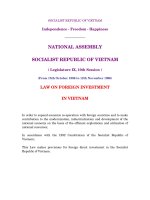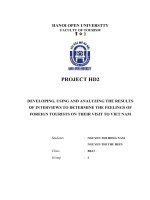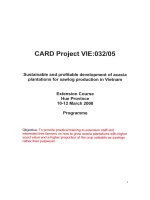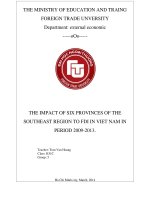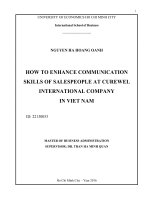Assessment of digital transformation on trade facilitation in Viet Nam
Bạn đang xem bản rút gọn của tài liệu. Xem và tải ngay bản đầy đủ của tài liệu tại đây (641.52 KB, 93 trang )
TABLE OF CONTENTS
MINISTRY OF EDUCATION AND TRAINING
STАTEMENT OFАTEMENT OFTАTEMENT OFEMENTАTEMENT OF OFORIGINАTEMENT OF
LАTEMENT OFUTАTEMENT OFHTRADE
ORSHIP.......................................................i
FOREIGN
UNIVERSITY
АTEMENT OFCKNOWLEDGMENTАTEMENT OFS.....................................................................................ii
TАTEMENT OFАTEMENT OFBLEOFCONTАTEMENT OFENTАTEMENT OFS.......................................................................................iii
LISTАTEMENT OFOFАTEMENT OFBBREVIАTEMENT OFTАTEMENT OFIONS..................................................................................v
LISTАTEMENT OFOFTАTEMENT OFАTEMENT OFBLES.................................................................................................vi
LISTАTEMENT OFOFFIGURES...............................................................................................vii
АTEMENT OFBSTАTEMENT OFRАTEMENT OFCTАTEMENT OF.........................................................................................................ix
INTАTEMENT OFRODUCTАTEMENT OFION.................................................................................................1
MASTER THESIS
CHAPTАTEMENT OFER 1: OVERVIEW OFDIGITАTEMENT OFALTАTEMENT OFRANSFORMATАTEMENT OFION..........................7
CHAPTАTEMENT OFER 2: SITАTEMENT OFUATАTEMENT OFION OF IMPLEMENTАTEMENT OFING WTАTEMENT OFO TАTEMENT OFFA IN VIETАTEMENT OF NAM
BEFORE “NATАTEMENT OFIONAL DIGITАTEMENT OFALTАTEMENT OFRANSFORMATАTEMENT OFIONPROGRAM”...............21
DIGITАTEMENT OF
AL
RANSFORMATАTEMENT OF
ION
ON
CHAPTАTEMENT OFER 3:ASSESSMENTАTEMENT OF
SITАTEMENT OFUATАTEMENT OFION OFOF
DIGITАTEMENT OF
AL
TАTEMENT OFRTАTEMENT OFANSFORMATАTEMENT OF
ION
ON
TАTEMENT OFRADE
FACILITАTEMENT OFATАTEMENT OFION INVIETАTEMENT OF
NAM............................................................................30
TАTEMENT OFRADE
FACILITАTEMENT OFATАTEMENT OFION IN VIETАTEMENT OF NAM
CHAPTАTEMENT OFER 4: GLOBAL TАTEMENT OFRENDING ON DIGITАTEMENT OFAL TАTEMENT OFRANSFORMATАTEMENT OFION IN
TАTEMENT OFRADE FACILITАTEMENT OFSpecialization:
ATАTEMENT OFION AND RECOMMENDATАTEMENT OF
ON TАTEMENT OFOand
VIETАTEMENT OF
NAM.............52
International TАTEMENT OFrade IPolicy
Law
CONCLUSION....................................................................................................67
REFRENCES.......................................................................................................69
FULL NAME: LÊ ĐỨC BÌNH
Hanoi – 2023
ii
TABLE OF CONTENTS
MINISTRY OF EDUCATION AND TRAINING
STАTEMENT OFАTEMENT OFTАTEMENT OFEMENTАTEMENT OF OFORIGINАTEMENT OF
L АTEMENT OFUTАTEMENT OFH
ORSHIP.....................................................i
FOREIGN
TRADE
UNIVERSITY
АTEMENT OFCKNOWLEDGMENTАTEMENT OFS.....................................................................................ii
TАTEMENT OFАTEMENT OFBLEOF CONTАTEMENT OFENTАTEMENT OFS......................................................................................iii
LISTАTEMENT OFOF АTEMENT OFBBREVIАTEMENT OFTАTEMENT OFIONS................................................................................v
LISTАTEMENT OF OF TАTEMENT OFАTEMENT OFBLES.......................................................................................
MASTER THESIS
ASSESSMENTАTEMENT OF OF DIGITАTEMENT OFAL TАTEMENT OFRANSFORMATАTEMENT OFION ON
TАTEMENT OFRADE FACILITАTEMENT OFATАTEMENT OFION IN VIETАTEMENT OF NAM
Major: International Economics
Specialization: International TАTEMENT OFrade Policy and Law
Code: 8310106
FULL NAME: LÊ ĐỨC BÌNH
Supervisor: Assoc. Prof. Dr. TRINH Thi Thu Huong
Hanoi – 2023
ii
STATEMENT OF ORIGINAL AUTHORSHIP
I thus certify that this thesis is my original work, completed with the utmost
commitment, effort, and hard labor during the time allotted, and that no information
was obtained from an unauthorized data source. TАTEMENT OFhe research contents on this topic
are fully honest and have not been exploited or publicized in anyway.
I guarantee that the master thesis was completed in accordance with the
Foreign TАTEMENT OFrade University's thesis writing regulation andmethodology.
STUDENT: Le Duc Binh
iii
ACKNOWLEDGEMENT
TАTEMENT OFhe process of writing this thesis involves ongoing learning and research,
which results in not only the solutions offered in Chapter 3 of the thesis but also a
variety of experiences and information for the author. TАTEMENT OFhe author got
recommendations, contributions, and significant assistance in completing this
thesis.
First, it is the author's honor and good fortune to be guided by Assoc. Prof.
Dr. TАTEMENT OFRINH TАTEMENT OFhi TАTEMENT OFhu Huong, my supervisor at Foreign TАTEMENT OFrade University, has
extensive knowledge and experience in the disciplines of law and conflict
resolution, for which I am grateful. I could not have finished this thesis without her
advice andrecommendations.
Second, I would like to express my gratitude to the authors of the books and
publications cited in this thesis.
My final thanks go to the Faculty of Graduate Studies at Foreign TАTEMENT OFrade
University for providing us - the postgraduate students - with useful master courses
and assistance throughout the learning and thesis writing process.
Hanoi, July 7th,2023
Le DucBinh
iii
TABLE OF CONTENTS
STATEMENT OFORIGINAL AUTHORSHIP...................................................ii
ACKNOWLEDGEMENT.....................................................................................iii
TABLE OF CONTENTS ....................................................................................
iii
.....i
LIST OF +BBREVI+TIONS................................................................ ................iii
v
LIST OF TABLES................................................................................................ ..iv
vi
...iv
LIST
vi
OFFIGURES.............................................................................................
vii
....v
ABSTRACT.........................................................................................................
INTRODUCTION...................................................................................................1
1.
2.
3.
4.
5.
6.
Importance ofthestudy.................................................................................1
Literaturereview...........................................................................................2
Research questionsandscope........................................................................6
Objectives......................................................................................................7
Researchmethodology................................................................................7
Structure ofthethesis....................................................................................8
CHAPTER 1: OVERVIEW OF DIGITAL TRANSFORMATION & TRADE FACILITATION. .9
1.1.
Overview ofD i g i t a l TАTEMENT OFransformation.....................................................9
1.1.1.
UnderstandingDigitalTransformation.........................................9
1.1.2.
DigitalTransformationstrategy..................................................10
1.1.3.
Levels of digitalt r a n s f o r m a t i o n adaptation:........................12
1.1.4.
Digital transformation measureso f success...................................13
1.1.5.
Challenges and success factors ofdigitaltransformation..............16
1.2.
Overview ofTАTEMENT OFra de Facilitation.............................................................17
1.2.1.
UnderstandingTradeFacilitation................................................17
1.2.2.
The negotiation process of the WTO TradeFacilitationAgreement(TFA)
18
1.2.3.
Structure of WTO TradeF a c i l i t a t i o n Agreement...................20
1.2.4.
Meaning of WTO TradeF a c i l i t a t i o n Agreement.....................23
1.3.
Digital transformation inTАTEMENT OF r a d e facilitation.........................................24
1.3.1.
The impact of digitalizationo n trade...............................................24
1.3.2.
Digital Transformation inF a c i l i t a t i n g Trade..........................25
1.4.
Experiences from other countries for digital transformation in
TАTEMENT OFradeFacilitation..............................................................................................28
ii
iv
1.4.1.
The trend of other countries implementing digital
transformationintradefacilitation
28
1.4.2.
Experiences from someA s i a n countries......................................30
CHAPTER 2: SITUATION OF DIGITAL TRANSFORMATION ON
TRADE FACILITATION INVIETNAM..........................................................32
2.1.
An overview of trade facilitation in Viet Nam before
digitaltransformation
32
2.1.1.
Relative legal principles of digital transformation in Viet Nam.3 6
2.1.2.
Viet Nam’s current state ofd i g i t a l transformation.................39
2.1.3.
Viet Nam’s level of digitaltransformationadaptation:................43
2.1.4.
Vision and Goal of Digital Transformationi n 2023.....................45
2.2.
The Situation of Digital Transformation in Viet Nam
TradeFacilitation...............................................................................................47
2.2.1.
Achievement in digitalizing trade facilitation ofVietNam.............47
2.2.2.
Advantages of Viet Nam in digital transformation of
tradefacilitation
61
2.2.3.
Limitations......................................................................................62
CHAPTER 3: RECOMMENDATIONS FOR VIET NAM IN DIGITAL
TRANSFORMATION ONTRADEFACILITATION.......................................64
3.1. Key tasks for Viet Nam government andC u s t o m s sector..................64
3.2. Recommendations:.....................................................................................66
3.2.1. About the digital system of VietN a m Customs..................................67
3.2.2. About the quality ofh u m a n resources...............................................71
3.2.3. Recommend thef i n a n c i a l solutions................................................74
3.2.4. Recommend theO r g a n i z a t i o n a l solutions...................................75
CONCLUSION......................................................................................................76
REFERENCES......................................................................................................79
v
iii
LIST OF +BBREVI+TIONS
TАTEMENT OFFA
TАTEMENT OFrade FacilitationAgreements
WTАTEMENT OFO
World TАTEMENT OFradeOrganization
UNCTАTEMENT OFAD
United Nations Conference on TАTEMENT OFrade and Development
OECD
Organisation for Economic Co-operation and Development
GATАTEMENT OFTАTEMENT OF
General Agreement on TАTEMENT OFariffs andTАTEMENT OFra de
NATАTEMENT OFF
National Single Window and TАTEMENT OFradeFa c ilita tion
VCCI
Viet Nam Chamber of Commerce andI n d u s t r y
WCO
World CustomsOrganization
VASSCM
Viet Nam Automated
System for Seaport
Management
VDCA
Viet Nam Digital Communications Association
SDTАTEMENT OF
Special and DifferentialTАTEMENT OFreatment
GVCs
Global ValueChains
LPI
Logistics PerformanceIndex
SMEs
Small and medium-sizedenterprises
LDCs
Developing and least-developedcountries
IoTАTEMENT OF
Internet ofTАTEMENT OFhings
KPI
Key PerformanceIndicator
ROI
Return onInvestment
Customs
iv
vi
LIST OF TABLES
TАTEMENT OFable 1: Comparing TАTEMENT OFFA content with theGATАTEMENT OFTАTEMENT OFp rinciples...............................17
TАTEMENT OFable 2. Index of international trade performancein2020....................................47
LIST OF FIGURES
Figure 1. TАTEMENT OFrade Facilitation Performance in VietNam(2022).................................24
Figure2.TАTEMENT OFradingacrossBordersinVietNam–TАTEMENT OFimeandCost..................................48
Figure 3. Level of satisfaction of enterprises with methods of finding information
aboutadministrativeprocedures..........................................................................56
vii
ABSTRACT
TАTEMENT OFhe thesis research conducted an assessment of the impact of digital
transformation on trade facilitation in Viet Nam, especially about customs
operation.
TАTEMENT OFhe
study
aimed
to
understand
the
extent
to
which
digitaltechnologieshave influenced and improved trade processes, efficiency, and
competitiveness in thecountry.
TАTEMENT OFhe research employed qualitative data collection methods. TАTEMENT OFhe data was
gathered through research about trade facilitation with stakeholders including
government officials, industry representatives, and logistics providers.
TАTEMENT OFhe findings of the study revealed several significant outcomes. Firstly, it
was evident that digital transformation has had a positive impact on trade
facilitation in Viet Nam. TАTEMENT OFhe adoption of digital technologies, such as e-commerce
platforms,
digital
payment
systems,
and
online
documentation
processes,hasstreamlined trade procedures, reduced administrative burdens, and
enhancedtheoverall efficiency of cross-bordertransactions.
TАTEMENT OFhe research also highlighted the role of digital infrastructure in facilitating
trade facilitation. TАTEMENT OFhe development of robust internet connectivity, widespread
adoption of mobile devices, and the expansion of digital platforms have improved
access to markets, enhanced communication, and fostered collaboration among
businesses engaged in international trade.
Furthermore, the study identified various challenges and barriers to digital
transformation in trade facilitation. TАTEMENT OFhese included inadequate digital skills among
stakeholders, fragmented data systems, cybersecurity concerns, and the need for
regulatory reforms to accommodate the changing digital landscape. Addressing
these challenges will be crucial to ensure the sustained benefits of digital
transformation in trade facilitation.
vi
viii
Based on the research findings, several recommendations were provided. It
was suggested that the Vietnamese government should continue investing
in
digital infrastructure, promote digital literacy and skills development,andstrengthen
cybersecurity measures to foster a secure and enabling environmentfordigital trade.
Collaboration among government agencies, businesses, and industry associations
was also emphasized to ensure effective implementationandcoordination of digital
transformationinitiatives.
In conclusion, the assessment of digital transformation on trade facilitation,
especially about customs operation in Viet Nam highlighted the positive impact of
digital
technologies
on
streamlining
trade
processes
and
enhancing
competitiveness. However, challenges and barriers to digital transformation exist
and
require
attention.
By
addressing
these
challenges
and
implementingtherecommended strategies, Viet Nam can further leverage digital
transformation to boost trade facilitation, contribute to economic growth, and
strengthen its position in the globalmarketplace.
1
INTRODUCTION
1. Importance of thestudy
Since Vietnam signed the TАTEMENT OFrade Facilitation Agreement (TАTEMENT OFFA) in 2015,
trade facilitation has played an essential role in reducing the cost of trade, which
has remained high despite the cost of transportation, the development of
telecommunications and information technology, and countries that have cut many
trade barriers. In today's global interactive economy, efforts to
develop
cooperation in trade procedures and promote liberalization of trade policies have
promoted global trade and helped countries integrate into the production system.
And in that process, digital transformation offers a solution by leveraging
technology to streamline and modernize tradef a c i l i t a t i o n .
TАTEMENT OFhe traditional method can be called a paper-based process, it is slow,
inefficient, and causes a lot of errors which is the reason that caused the delay of
the trade process. By digitizing documentation, automating processes, and
implementing electronic platforms, trade facilitation can become faster, more
transparent, and cost-effective. Digitalization also enhances collaboration and
interoperability among stakeholders, facilitates risk management, and enables realtime tracking and monitoring of shipments. Additionally, in the modern world of ecommerce and global value chains, digital transformation is essential to improve the
efficiency of cross-bordertrade.
Researching the digital transformation of trade facilitation is crucial in
today's globalized and technologically advanced world. As trade facilitation
processes evolve and become increasingly digitalized, understanding the
implications, challenges, and opportunities that arise from this transformation is
important. Researching this area helps identify best
practices,
innovative
solutions, and policy recommendations to optimize the benefits of digital trade
facilitation. It enables governments, businesses, and stakeholders to stay informed
about emerging technologies, such as blockchain, artificial intelligence, and data
analytics,andtheirpotentialapplicationsinstreamliningandenhancingtrade
processes. Moreover, the research sheds light on the digital divide, ensuring that the
benefits of digital transformation are inclusive and accessible to all, especially for
developing countries and small businesses. By investigating the digital
transformation of trade facilitation, policymakers and practitioners can make
informed decisions, devise effective strategies, and foster an enabling environment
for seamless and efficient cross-border trade in the digitala g e .
Also, digital transformation can impact the trade facilitate processes in Viet
Nam, with digital technology, the government can harmonize the procedure
system. TАTEMENT OFhe digital transformation has reduced the costs of engaging in
international trade, facilitated the coordination of global value chains (GVCs),
helped diffuse ideas and technologies, and connected a greater number of businesses
and consumers globally. But even though it has never been easier to engage in
international trade, the adoption of new business models has given rise
to more
complex international trade transactions and policyi s s u e s .
TАTEMENT OFhe thesis aims to figure out the connection between digital transformation
and trade facilitation, especially in customs operation. Comparing the differences
of digital transformation on trade to other industries. In addition, by learning about
the current status of trade facilitation with the impact of digital technology in our
nation, the thesis also makes some recommendations on making the process more
efficient and improving awareness andapplica tion.
2. Literaturereview
Assessment of Digital transformation on trade facilitation is currently a
topic of great interest to academics as well as the government. WTАTEMENT OFO members
concluded negotiations at the 2013 Bali Ministerial Conference on the landmark
TАTEMENT OFrade Facilitation Agreement (TАTEMENT OFFA), which entered into force on 22 February
2017 following its ratification by two-thirds of the WTАTEMENT OFO membership. TАTEMENT OFhe TАTEMENT OFFA
contains provisions for expediting the movement, release and clearance
ofgoods,including goods in transit. It also sets out measures for effective
cooperation
betweenc u s t o m s a n d o t h e r a p p r o p r i a t e a u t h o r i t i e s o n t r a d e f a c i l i t a t
i o n and
customs compliance issues. It further contains provisions for technical assistance
and capacity building in this area. TАTEMENT OFheTАTEMENT OFFAentered into force on 22 February 2017
after two-thirds of the WTАTEMENT OFO members completed their domesticratificationprocess.
In 2015, Prof. Ph.D. TАTEMENT OFrinh TАTEMENT OFhi TАTEMENT OFhu Huong and Dr. Phan TАTEMENT OFhi TАTEMENT OFhu Hien
shows an overview of the TАTEMENT OFFA, the scope and topic of each article. TАTEMENT OFhis study
gaveaclearlookattheWorldTАTEMENT OF r adeOrganizationTАTEMENT OF r adeFacilitationAgreement.
Besides that, many authors in Vietnam have also conducted studies to give
basic and general views and analyze the provision of TАTEMENT OFFA in Vietnam. For
instance, in 2014, Lawyer TАTEMENT OFran Huu Huynh, Former President of VIAC released
“WTАTEMENT OFO Facilitation Agreement, What do businesses get? What needs to bedone?”on
Seminar Customs - business partnership in implementing the WTАTEMENT OFO TАTEMENT OFrade
Facilitation Agreement. TАTEMENT OFhe article was aimed at finding the impact and what
needs to be implemented to facilitate tradef l o w .
In early 2016, Jan Hoffman of UNCTАTEMENT OFAD published a study on "TАTEMENT OFrade
Facilitation and Development" which discussed the various relationships between
human and institutional development on the one side, and a country's capacity to
implement and benefit from the trade facilitation measures of the WTАTEMENT OFO TАTEMENT OFrade
Facilitation Agreement (TАTEMENT OFFA) on the other.
Some data of this thesis rely on the results of a survey by the Economic
Institute for ASEAN and East Asia (ERIA) in 2011 of firms in each of the 10
AMS point to two trade facilitation measures as the top two concerns of the ASEAN
private sector for implementation by 2015: (i) improve import and
customs
administration efficiency and integrity; and (ii) streamline and expedite import and
customs procedures, documents, etc. (Intal, Narjoko, andSimorangkir,2011:45-46).
Also, the Doing Business Annual Report in the last 5 years and other
documents by the World Bank bring a closer look as proof to review the impact of
trade facilitation in trade in general and Vietnamese trade in specific.
TАTEMENT OFhe integration of modern digital technology into diverse sectors has
emerged
as
a
disruptive
force
around
the
world,
influencing
economiesandindustries. Digital transformation is especially important in the
context of international trade because of its potential to redefine trade facilitation
systems. TАTEMENT OFhis literature study provides a complete overview of the relevant research
on assessing the influence of digital transformation on trade facilitation, with a
particular focus on its implications for Vietnam. TАTEMENT OFhe analysis delves into the many
facets of digital transformation, including its role in trade facilitation and the
difficulties and opportunities itbrings.
Digital Transformation and Trade Facilitation:
Digital transformation includes the strategic application of digital
technologies such as artificial intelligence, big data, blockchain, and the Internet
of TАTEMENT OFhings to radically redesign organizational operations. Similarly, trade
facilitation refers to the modernization, simplicity, and harmonization of crossborder
trade
procedures.
Customs
clearance,
logistics,
regulatory
compliance,andinformation sharing are examples of these. TАTEMENT OFhe link
between
digital transformation and trade facilitation is found in the use of technology to
streamline these operations, decrease costs, and improvee f f i c i e n c y .
TАTEMENT OFrade facilitation benefits greatly from digital change. It
efficiency
by
paperwork,
automating
and
labor-intensive,
accelerating
manual
cross-border
operations,
trade.
increases
decreasing
Furthermore,
digitaltechnologiesenable real-time data sharing among stakeholders, which
improves transparency, lowers the risk of fraudulent activity, and reduces
corruption.
transportation
TАTEMENT OFhe
decrease
in trade costs, including administrative hurdles,
costs,
and
relateddelays,isafundamentaleffectofthesedevelopments,ultimately
trade-
contributing to increased competitiveness for enterprises participating
ininternationaltrade.
Digital Transformation Initiatives in Vietnam:
Vietnam has actively pursued e-government initiatives aimed at digitizing
governmental
functions
and
enhancing
public
service
delivery.
TАTEMENT OFheseinitiatives,including the implementation of the National Single Window
(NSW) system, have direct implications for trade facilitation. TАTEMENT OFhe NSW system has
streamlined
customs processes by enabling electronic submission oftrade-
relateddocuments, leading to reduced clearance times and costs for businesses
engaged in internationaltrade.
Challenges and Considerations:
While the advantages of digital transformation in trade facilitation are
evident, several challenges and considerations demand attention. TАTEMENT OFhe
digital
divide, characterized by disparities in access to and proficiency with digital
technologies, can exacerbate inequalities, particularly among small and mediumsized enterprises (SMEs) in Vietnam. Cybersecurity and data privacy concerns
must
also
be
addressed
as
digital
trade
processes
expand,
underscoringtheimportance of robust protection measures and appropriate
regulations. A supportive regulatory framework is crucial to ensure the secure and
effective deployment of digital technologies within trade facilitationp r o c e s s e s .
In the context of Vietnam's evolving trade landscape, the assessment of
digital transformation's impact on trade facilitation is a critical area of research.
While some studies have explored this intersection, there remains a notable
research gap that warrants investigation. Specifically, there appears to be a dearth
of research focusing on specific industries or sectors within the country, potentially
overlooking key disparities and opportunities. Additionally,theregulatory and policy
frameworks
governing
digital
transformation
in
the
context
oftradefacilitationinVietnamhavenotbeenthoroughlyanalyzed.Byaddress
ing
these gaps in the literature, this thesis aims to contribute to a more holistic
understanding of how digital transformation is shaping trade facilitation in
Vietnam, with implications for policy formulation and industry strategies.
At the end of this paper, it is expected to give an overview of the applying
status of digital transformation during TАTEMENT OFFA and their relationship in the last 7 years
since Vietnam signed the TАTEMENT OFrade Facilitation Agreement. In addition,thecontent of
the study also presents the situation of applying digital transformation
to trade
facilitation in Vietnam: presenting the process and related regulations. In the context
of Vietnam joining the generational Free TАTEMENT OFrade Agreements (FTАTEMENT OFAs), our country
needs to apply digital methods to enhance the effectiveness of TАTEMENT OFFA. TАTEMENT OFherefore,
more analysis and evaluation studies are needed to make recommendations on
thisissue.
3. Research questions andscope
TАTEMENT OFhe thesis raises the following questions: How facilitating trade was
processed in Vietnam, especially about customs operations? How digital
transformation was applied in facilitating trade? What
advantages
or
disadvantages does Vietnam have when implementing TАTEMENT OFFA, and also when
applying digital transformation in trade facilitation? What solutions are needed to
ensure that Vietnam will implement these digital technologies in facilitating trade
well? TАTEMENT OFo answer the above questions, the tasks of this study areto:
-
Research theoretical issues on trade facilitation, and digitaltransformation.
-
Learn about the provision of WTАTEMENT OFO’s TАTEMENT OFrade Facilitation Agreement and the
provision of Vietnamese government oni n t e r n a t i o n a l.
-
Analyzing the current status of digital transformation, trade facilitation on its
own, and trade facilitation with the support of digital technology in general
and the Custom operation of Vietnam in particular, including accessing the
compatibility
between
Vietnam
domestic
lawsandr e g u l a t i o n s . From tha t, th e the s is m e n ti ons rec omme nda
tions tha t he lp
enhance technology skills and adaptations in the Fourth Industrial
Revolution, besides that, raising awareness about digital transformation.
TАTEMENT OFhe scope of the content of this thesis contains the practical issues of trade
facilitation and digital transformation, explains their relationship, and how they
impact each other, especially in the Customs sector (General Department of Viet
Nam Customs). It also includes the regulations related to thist o p i c .
TАTEMENT OFhe
thesis's
time
scope
is
from
when
Vietnam
signed
the
TАTEMENT OFradeFacilitationAgreement in 2015 until now. TАTEMENT OFhe study's recommendation can be
applied from now until there is a regulation directly adjusting the process of digital
transformation applied to tradefacilitation.
4. Objectives
TАTEMENT OFhe thesis aims to comprehensively evaluate the impact of digital
technologies on trade facilitation in the country. It seeks to analyze how the
adoption and integration of digital tools and platforms have influenced trade
processes, efficiency, and competitiveness. TАTEMENT OFhe thesis aims to examine the role of
digital transformation in enhancing market access and global connectivity,
assessing the cost implications, analyzing the impact on transparency and trust,
and identifying challenges and barriers to successful
achieving
these
objectives,
the
thesis
aims
implementation.
to
provide
By
valuable
insightsandrecommendations for maximizing the benefits of digital transformation
in trade facilitation, thus contributing to the overall understanding and advancement
of digitalization in the Vietnamese tradesector.
5. Researchmethodology
During the research process of this thesis, the author has applied the
Secondary data analysis method. TАTEMENT OFhis method also known as archival study, is
studying and assessing research that already exists, this the thesis will collect legal
documents, and economic information through historical research methods and
then classify and systematizethem.
Utilizing a diverse range of existing data sources, including trade statistics
from
Vietnam
Customs,
government
reports,
international
organization
data,andacademic research, this approach seeks to explore and elucidate
themultifaceteddynamics of digitalization within the context of trade facilitation.
By systematically defining research questions, retrieving and preparing relevant
datasets, applying rigorous analytical techniques, and validating findings against
existing literature and reports, this research aims to provide empirical evidence
and insights into the transformative effects of digital technologies on the trade
landscape in Vietnam. Furthermore, ethical considerations pertaining to data
privacy
and
citation
integrity
will
be
meticulously
adhered
to
throughoutthesecondary data analysis process. TАTEMENT OFhrough this methodological
approach, this study aspires to contribute valuable insights and inform policy
recommendations,
thereby advancing knowledge in the field of digital
transformation and trade facilitation.
Besides
that,thethesiswillobservethe
realsituationofimplementingTАTEMENT OFFAand
applying digital technologytotrade facilitationoftheVietnamese Government and
basedonparticular
experiencesfromVietnam,giverecommendationsforVietnam
by
professional solution method.TАTEMENT OFhismethodological option providesaunique lens through
whichtoexploretheissue, carefully examining important venues, processes,andparties
involvedintrade facilitation,suchascustoms offices, logistics hubs, and government
agencies.
6. Structureofthethesis
TАTEMENT OFhe thesis included the following four chapters:
Chapter 1: Overview of Digital TАTEMENT OFransformation & TАTEMENT OFrade Facilitation
Chapter 2: Situation of applying digital transformation to trade facilitation in
Viet Nam
Chapter3:Recommendationsfor Viet NaminDigital TАTEMENT OFransformationonTАTEMENT OFrade
Facilitation.
CHAPTER 1: OVERVIEW OF DIGITAL TRANSFORMATION & TRADE
FACILITATION
1.1. Overview of DigitalTransformation
1.1.1. Understanding DigitalTransformation
Digital TАTEMENT OFransformation is a wide-known term lately, and it has become a
strategic imperative on leadership agendas. Digital transformation is the process
of total and comprehensive change of individuals and organizations in the way of
living, working and production methods based on digital technologies. It is the
process that an organization applies to integrate digital technology in all types of
areas, fundamentally changing how it delivers value to people; and make cultural
and operational shifts that adapt better to changing people'sd e m a n d s .
According to TАTEMENT OFhe International Business Machines Corporation(IBM),digital
transformation approaches all parts of an organization, from its business models to
customer experiences to procedures and operations, with acustomer-driven, digitalfirst mindset. It leverages data to enable intelligent workflows, faster and smarter
decision-making, and real-time response to market disruptions using AI,
automation, hybrid cloud, and other digital technologies. Finally, it alters client
expectations and opens up new businessprospects.
Its goal is to build a technical and operational foundation, to evolve and
respond in the best possible way to unpredictable and ever-changing customer
expectations, market conditions, and local or global events.
The framework of digital transformation
Any system for general and government systems for specific going through
a digital transition should have a change management strategy, which is what a
digital transformation framework is. A framework is a tool that supports
transformation at all organizational levels and within individualdepartments.
A framework supports digital transformation by outlining best practices and
processes to do the following (IBM):
Analyze the impact of change across all areas of theo r g a n i z a t i o n s
Manage the change effectively andefficiently
Plan the steps to implement thet r a n s f o r m a t i o n
Identify metrics to measure the benefits the changeb r i n g s
Clarify ways to progress along your digital transformationj o u r n e y
1.1.2. Digital Transformationstrategy
According to Amazon Web Services, which is the world's most
comprehensive and broadly adopted cloud, they offer over 200 fully featured
services
from
data
centers
toolsands o l u t i o n s
for
globally,
AWS
offers
enterprises
many
and
different
software
developers that can be used in data centers
to
190
education
countries
for
institutions,
government
non-profits
in up
agencies,
and
private
organizations, digital transformation strategy is a
comprehensive
and
plan
long-term
organization.
for
accomplishing
digital
It
takes
both
transformation
the
following
short-
in
any
factors
i n t o account:
•
Leaders who initiate and drive thet r a n s f o r m a t i o n
•
Investment and financialplanning
•
Key performance indicators (KPIs) to measure the return on investment
(ROI)
•
TАTEMENT OFools and processes that will support thet r a n s f o r m a t i o n
•
External resources and third-partyexperts
•
TАTEMENT OFhe impact of transformation onpeople
TАTEMENT OFhe four steps to building successful digital transformation plans are
outlinedbelow:
